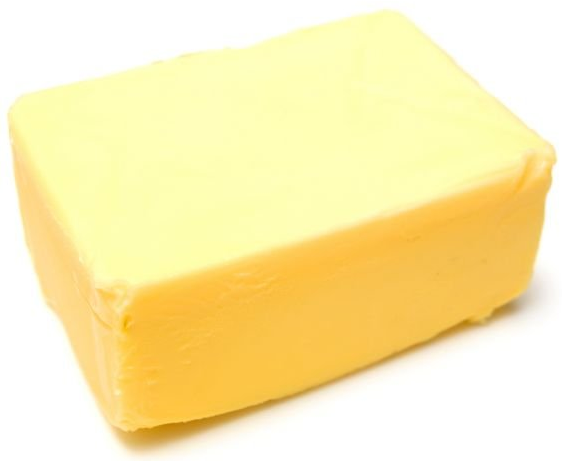 This morning for breakfast, as with most mornings I had two eggs on whole grain toast, with BUTTER!! Yes, that’s right folks, good good golden butter. I’ve had people ask me why I choose to eat butter instead of margarine since margarine is so much ‘healthier’. After I explain the history of margarine and the truth behind all of its fancy messaging, packaging, and health claims, they are often shocked with what they have learned. Let’s take a closer look to see what naked truth we can uncover today.
This morning for breakfast, as with most mornings I had two eggs on whole grain toast, with BUTTER!! Yes, that’s right folks, good good golden butter. I’ve had people ask me why I choose to eat butter instead of margarine since margarine is so much ‘healthier’. After I explain the history of margarine and the truth behind all of its fancy messaging, packaging, and health claims, they are often shocked with what they have learned. Let’s take a closer look to see what naked truth we can uncover today.
Below I have undressed one butter and four margarine products to expose their ingredients.

Learning more about the history of these products and their ingredients will help us to better understand their “true” health benefits.
Back In The Day:
Margarine was introduced as a substitute to butter, not because of its health benefits but because butter was in short supply and margarine was a cheap alternative. Over time margarine companies used creative messages to help increase consumption of their product. Instead of taking the “it’s not better than butter but it’s cheaper” route, margarine companies promoted the “health” benefits of the product so that consumers would be convinced that it was the healthier choice and make the switch. How did they do this you ask? Well, they used messages about margarine being lower in saturated fat and cholesterol than butter, claiming that this meant their product was healthier. Sadly, it worked and millions of consumers made the switch. Now this may confuse some of you who are under the impression that saturated fat and cholesterol should be avoided at all cost. Let’s take a closer look at what margarine is made of and the truth behind saturated fat and cholesterol. This should help us declare a clear winner.
Margarine In The Nude:
Butter is made up of mostly natural saturated fat, and since saturated fat is solid at room temperature, so is butter. Margarine is made up of mainly polyunsaturated fat, and since polyunsaturated fat is liquid at room temperature, so is marg….. wait a second, margarine isn’t liquid at room temperature. So how do they make it look like butter? To create margarine, cheap vegetable oil is first put through a process called hydrogenation. This involves mixing the oil with tiny metal particles (usually nickel), then heating it to very high temperatures under high pressure and bubbling hydrogen through the oil (the metal helps to combine the oil and hydrogen). When this is done, the finished product is an unappetizing dark colour. This is not attractive for consumers so it is put through a bleaching process that turns it to a white colour. However, butter isn’t white so they then add colouring agents, to make it look like butter, flavouring agents to make it taste like butter, other agents to make it cook like butter, and don’t forget all the preservatives!
Although the original claims about being lower in saturated fat and cholesterol were truthful, they were misleading in that they left out the part about their products being made of TRANS FAT (the fat that is created when hydrogenating the polyunsaturated fats). It wasn’t until regulation bodies started to put rules in place that forced manufacturers to tell consumers about the amount of trans fat in their products that margarine companies went back to the drawing board. Now that the secret was out of the bag they needed to create a new type of product that they could claim was non-hydrogenated and therefore, once-again, healthy. Products like the Becel brand listed above are examples of this new and improved “spreadable” margarine.
At first glance this product may seem like the answer to all of our problems. They sure claim that it is. But is it? Although it doesn’t contain hydrogenated vegetable oils, it still has all of the preservatives, colourings, and flavourings. Also, this product contains “modified” palm and palm kernel oil which helps to ensure the product isn’t liquid at room temperature. We know that the biggest problem was with the hydrogenated vegetable oil, so other than the few additives list above, is there anything else wrong with this new wonder margarine?
The problem now actually lies with the polyunsaturated fat (e.g. corn oil, soybean oil, safflower oil, etc.). Although this type of fat is considered healthy (in moderation) it is very unstable. Unstable means that when it is exposed to oxygen, heat, or liquid, it becomes ‘rancid’, in other words it creates a large amount of free radicals which when consumed are bad for us (leading to problems like aging, tissue damage, and in some cases disease such as heart disease). So it is not that polyunsaturated fat is bad for us, but it is bad for us when it is oxidized and consumed too frequently. The problem is that almost all of the polyunsaturated vegetable oil we consume (such as that in margarine) is already rancid, even before it is purchased.
Now that we have seen why margarine is bad for us, let’s look at butter, is it any better? We have been told that butter is bad because it contains saturated fat and cholesterol. Let’s undress the situation.
The Truth about Saturated Fat and Cholesterol:
Unfortunately, saturated fats and cholesterol have gotten a bad rap. The problem is one of cause and effect. Many studies were conducted on individuals who had heart problems with the results indicating high levels of saturated fat and cholesterol in their system. It was then decided that eating saturated fat and cholesterol resulted in poor heart health and that to be healthy one should minimize the consumption of both. More recent studies have revealed that both saturated fat and cholesterol are not the direct culprit and that in fact we need both in our diet, as they provide positive health benefits. So what is to blame? Many additional studies have shown that the problem is the consumption of too many vegetable oils, hydrogenated oils, processed foods, sugars, bad carbs, as well as smoking, stress, and a lack of exercise. In the end, high levels of saturated fat and cholesterol are in fact the effect and not the cause.
Let’s now take a closer look as some of the benefits of both saturated fat and cholesterol:
Saturated Fat Benefits: It gives our cells the necessary stiffness and integrity (50% of our cell membranes are made up of saturated fatty acids), it helps to protect our digestive tract from harm, it helps our heart during stressful times, it helps us to utilize the omega-3 fatty acids that we eat, it helps to protect our liver from toxins, it enhances our immune system, it helps calcium incorporate into our bones, etc.
Cholesterol Benefits: It helps serotonin receptors (the feel good chemical) work properly, it helps with brain and nervous system development in children (mother’s milk is especially rich in cholesterol), it helps keep our intestines healthy, it is an antioxidant (it helps fight the free-radicals that are in the rancid vegetable oil we eat), it helps with digestion, it is even involved with helping to protect us against stress and many diseases such as cancer and heart disease!
Now that we know the naked truth, I think it’s time we let the butter out of the doghouse. I know that the next time I am at the grocery store I will be reaching for butter instead of margarine.
Health Tip: When buying butter, try the unsalted option. It still tastes great but contains much less sodium.


